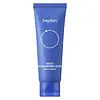What's inside
What's inside
 Key Ingredients
Key Ingredients

 Benefits
Benefits

 Concerns
Concerns

No concerns
 Ingredients Side-by-side
Ingredients Side-by-side

Water
Skin ConditioningGlycerin
HumectantPropanediol
SolventHydrogenated Poly(C6-14 Olefin)
Emollient1,2-Hexanediol
Skin ConditioningCaprylic/Capric Triglyceride
MaskingCetyl Ethylhexanoate
EmollientPolyglycerin-3
HumectantOctyldodecanol
EmollientCetearyl Olivate
Squalane
EmollientAmmonium Acryloyldimethyltaurate/Vp Copolymer
Sorbitan Olivate
EmulsifyingCarbomer
Emulsion StabilisingButylene Glycol
HumectantTremella Fuciformis Polysaccharide
Emulsion StabilisingTromethamine
BufferingPanthenol
Skin ConditioningEthylhexylglycerin
Skin ConditioningAllantoin
Skin ConditioningSaccharide Hydrolysate
HumectantGardenia Florida Fruit Extract
Skin ConditioningXanthan Gum
EmulsifyingDipotassium Glycyrrhizate
HumectantAdenosine
Skin ConditioningSodium Hyaluronate
HumectantCoptis Japonica Extract
AntimicrobialXylitylglucoside
HumectantIndigofera Tinctoria Extract
MaskingAnhydroxylitol
HumectantAgave Tequilana Leaf Extract
AstringentMoringa Oleifera Seed Oil
EmollientXylitol
HumectantHemerocallis Fulva Flower Extract
Skin ConditioningCeramide NP
Skin ConditioningGlucose
HumectantMyosotis Sylvatica Flower/Leaf/Stem Extract
Skin ConditioningPhytosphingosine
Skin ConditioningHydrogenated Lecithin
EmulsifyingBeta-Glucan
Skin ConditioningHyaluronic Acid
HumectantWater, Glycerin, Propanediol, Hydrogenated Poly(C6-14 Olefin), 1,2-Hexanediol, Caprylic/Capric Triglyceride, Cetyl Ethylhexanoate, Polyglycerin-3, Octyldodecanol, Cetearyl Olivate, Squalane, Ammonium Acryloyldimethyltaurate/Vp Copolymer, Sorbitan Olivate, Carbomer, Butylene Glycol, Tremella Fuciformis Polysaccharide, Tromethamine, Panthenol, Ethylhexylglycerin, Allantoin, Saccharide Hydrolysate, Gardenia Florida Fruit Extract, Xanthan Gum, Dipotassium Glycyrrhizate, Adenosine, Sodium Hyaluronate, Coptis Japonica Extract, Xylitylglucoside, Indigofera Tinctoria Extract, Anhydroxylitol, Agave Tequilana Leaf Extract, Moringa Oleifera Seed Oil, Xylitol, Hemerocallis Fulva Flower Extract, Ceramide NP, Glucose, Myosotis Sylvatica Flower/Leaf/Stem Extract, Phytosphingosine, Hydrogenated Lecithin, Beta-Glucan, Hyaluronic Acid
Water
Skin ConditioningSimmondsia Chinensis Seed Oil
EmollientGlycerin
HumectantCaprylic/Capric Triglyceride
MaskingGlyceryl Stearate
EmollientBehenyl Alcohol
EmollientDicaprylyl Carbonate
EmollientIsoamyl Laurate
EmollientRosa Damascena Flower Water
MaskingHippophae Rhamnoides Fruit Extract
Skin ConditioningSodium PCA
HumectantSodium Levulinate
Skin ConditioningAroma
Cetearyl Alcohol
EmollientLecithin
EmollientCellulose
AbsorbentSodium Anisate
AntimicrobialPalmitic Acid
EmollientStearic Acid
CleansingLactic Acid
BufferingGlycine Soja Sterols
EmollientLinum Usitatissimum Seed Extract
PerfumingUrtica Dioica Leaf Extract
Skin ConditioningXanthan Gum
EmulsifyingPaeonia Lactiflora Root Extract
Skin ConditioningSodium Hyaluronate
HumectantSodium Phytate
Ascorbyl Palmitate
AntioxidantHydrolyzed Hyaluronic Acid
HumectantTocopherol
AntioxidantCI 77491
Cosmetic ColorantCitronellol
PerfumingGeraniol
PerfumingBenzyl Salicylate
PerfumingEugenol
PerfumingWater, Simmondsia Chinensis Seed Oil, Glycerin, Caprylic/Capric Triglyceride, Glyceryl Stearate, Behenyl Alcohol, Dicaprylyl Carbonate, Isoamyl Laurate, Rosa Damascena Flower Water, Hippophae Rhamnoides Fruit Extract, Sodium PCA, Sodium Levulinate, Aroma, Cetearyl Alcohol, Lecithin, Cellulose, Sodium Anisate, Palmitic Acid, Stearic Acid, Lactic Acid, Glycine Soja Sterols, Linum Usitatissimum Seed Extract, Urtica Dioica Leaf Extract, Xanthan Gum, Paeonia Lactiflora Root Extract, Sodium Hyaluronate, Sodium Phytate, Ascorbyl Palmitate, Hydrolyzed Hyaluronic Acid, Tocopherol, CI 77491, Citronellol, Geraniol, Benzyl Salicylate, Eugenol
 Reviews
Reviews

Ingredients Explained
These ingredients are found in both products.
Ingredients higher up in an ingredient list are typically present in a larger amount.
This ingredient is an emollient, solvent, and texture enhancer. It is considered a skin-softener by helping the skin prevent moisture loss.
It helps thicken a product's formula and makes it easier to spread by dissolving clumping compounds.
Caprylic Triglyceride is made by combining glycerin with coconut oil, forming a clear liquid.
While there is an assumption Caprylic Triglyceride can clog pores due to it being derived from coconut oil, there is no research supporting this.
Learn more about Caprylic/Capric TriglycerideGlycerin is already naturally found in your skin. It helps moisturize and protect your skin.
A study from 2016 found glycerin to be more effective as a humectant than AHAs and hyaluronic acid.
As a humectant, it helps the skin stay hydrated by pulling moisture to your skin. The low molecular weight of glycerin allows it to pull moisture into the deeper layers of your skin.
Hydrated skin improves your skin barrier; Your skin barrier helps protect against irritants and bacteria.
Glycerin has also been found to have antimicrobial and antiviral properties. Due to these properties, glycerin is often used in wound and burn treatments.
In cosmetics, glycerin is usually derived from plants such as soybean or palm. However, it can also be sourced from animals, such as tallow or animal fat.
This ingredient is organic, colorless, odorless, and non-toxic.
Glycerin is the name for this ingredient in American English. British English uses Glycerol/Glycerine.
Learn more about GlycerinSodium Hyaluronate is hyaluronic acid's salt form. It is commonly derived from the sodium salt of hyaluronic acid.
Like hyaluronic acid, it is great at holding water and acts as a humectant. This makes it a great skin hydrating ingredient.
Sodium Hyaluronate is naturally occurring in our bodies and is mostly found in eye fluid and joints.
These are some other common types of Hyaluronic Acid:
Learn more about Sodium HyaluronateWater. It's the most common cosmetic ingredient of all. You'll usually see it at the top of ingredient lists, meaning that it makes up the largest part of the product.
So why is it so popular? Water most often acts as a solvent - this means that it helps dissolve other ingredients into the formulation.
You'll also recognize water as that liquid we all need to stay alive. If you see this, drink a glass of water. Stay hydrated!
Learn more about WaterXanthan gum is used as a stabilizer and thickener within cosmetic products. It helps give products a sticky, thick feeling - preventing them from being too runny.
On the technical side of things, xanthan gum is a polysaccharide - a combination consisting of multiple sugar molecules bonded together.
Xanthan gum is a pretty common and great ingredient. It is a natural, non-toxic, non-irritating ingredient that is also commonly used in food products.
Learn more about Xanthan Gum